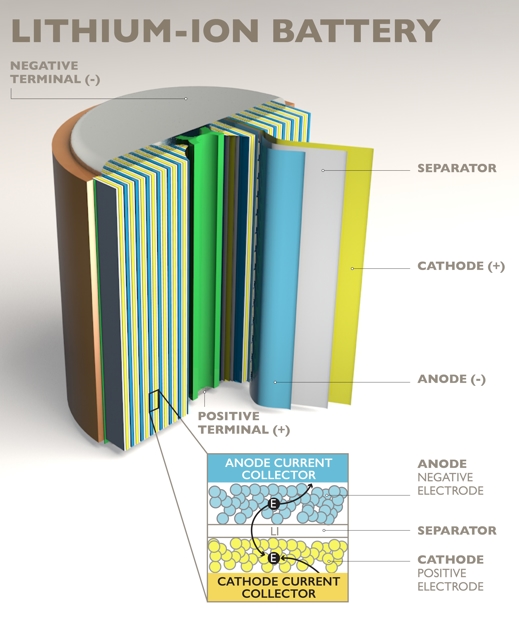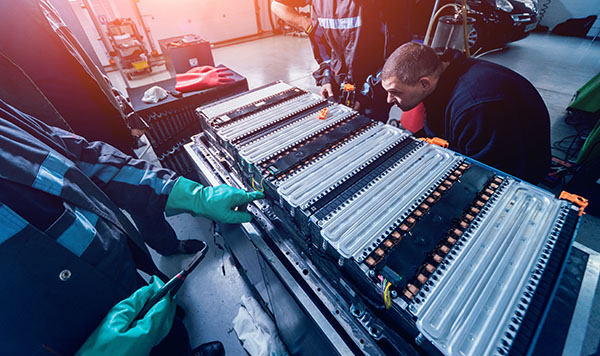The electric revolution is among us! With 145 million electric vehicles (EVs) expected to hit the road worldwide by 2030, we are quickly transitioning from relying on gas to batteries to help us get from point A to point B. While leaving the gas pump and dirty fossil fuels behind is exciting, it is important to plan ahead and start considering what we will do with the electronic waste on the horizon from our new reliance on batteries. By 2030, we can expect 11 million metric tons of lithium-ion batteries to reach their end of service life. Proper recycling of battery materials and electronics is essential to the establishment of a circular economy that prioritizes sustainability. Fortunately, discussions on how to expand the infrastructure needed for recycling these materials are taking place throughout the world as governments, manufacturing companies, and researchers prepare for our electric future.
In the United States, beyond the lithium-ion batteries used in many consumer electronics, few lithium-ion batteries have reached their end of life cycle since they haven’t been on the market longer than their typical service lifetime. It is the coming decades that we are concerned about when that number turns into millions of tons of batteries being decommissioned from electric cars, buses, trucks, and more.

Before we dive into the future of battery recycling, we remind you that Lithium-ion batteries are generally safe & stable when used properly, but should never be disposed of in household waste or recycling bins. Without being handled properly, batteries can lead to fire hazards. They also contain toxic metals that pose environmental harm and can cause toxic metal pollution.
Creating an efficient recycling infrastructure for EV batteries, in particular, has its challenges. With an EV battery, the main pack contains several modules, made of smaller cells. Within those cells, are metal cathodes composed of lithium and other elements like cobalt, nickel, manganese, and iron. These are some of the valuable materials that we want to recycle for future use. Recycling prevents the need to mine for more materials, disrupting our environment more than necessary.

Worker safety is another factor to consider in battery recycling. Dealing with toxic heavy metals poses risk to workers and opening lithium-ion batteries to access critical minerals is no easy feat as they are not designed for easy disassembly. Not all of them are designed the same either. Batteries come in different designs with adhesives, sealants, glues, and sometimes even concrete, making it difficult to automate the way they are taken apart. Workers attempting the operation manually can potentially hurt themselves in the process. Using robots for disassembly could solve the risks posed to human workers. Standardizing design, as well as battery materials, can also mitigate risks and could be more cost-effective.
Current extraction methods to pull these valuable elements are energy-intensive. Pyrometallurgy is the more common method currently used in recycling EV batteries. This requires shredding the cell mechanically, burning it, and taking several more steps to extract metals from the charred mass left over. Another method is hydrometallurgy which involves submerging the battery materials in acid. At times both processes are used and unfortunately both produce a lot of waste and emit greenhouse gases. Improving these processes mitigates pollution and helps our country secure much-needed precious resources to our domestic supply chain. Most mining for lithium, nickel, cobalt, and copper, is concentrated in other countries and often comes with poor labor standards. An expansive recycling industry in the U.S. can keep us from contributing to a potential mining boom fueled by what are often unethical labor practices in other nations.

Image Credit: EPA.gov
The U.S. Department of Energy (DOE) is investing in improving our E-recycling infrastructure, putting $15 million into studies by scientists, industry, and government laboratories. The DOE is also hosting a Lithium-Ion Battery Recycling Prize. This challenge is focused on identifying new solutions for transporting, storing, and recycling lithium-ion batteries for materials recovery. The prize is a $5.5 million phased competition intended to incentivize entrepreneurs who develop and demonstrate a process that has the potential to capture 90% of all discarded lithium-based batteries for recovery of key materials to be re-introduced to our domestic supply chain.
Vehicle manufacturers are doing some of the leg work themselves. Ford has partnered with Redwood Materials, a battery recycling company, to reuse raw materials from Ford EV batteries; a decision they made to reduce the reliance on importing raw materials and support the creation of a domestic supply chain that will make EVs more affordable and accessible to all. With their battery manufacturing partner, Ford hopes to secure a steady supply of lithium, nickel, copper, and other materials necessary to manufacture EV battery packs. Redwood Materials plans to expand in 2022 and begin, “to transform the lithium-ion battery supply chain by offering large-scale sources of these domestic materials produced from as many recycled batteries as available and augmented with sustainably mined material.” according to CEO JB Straubel.

General Motors is working with the Canadian firm Li-Cycle to recover raw materials from their Ultium battery cells. Li-Cycle plans to recycle up to 100% of materials recovered from battery-cell manufacturing. Most of GM’s current electric cars are repaired with refurbished battery packs.
According to Tesla, 100% of their scrapped lithium-ion batteries are recycled on-site. Their process claims to save up to 92% of the elements that make up the battery pack. They believe that the company responsible for making the battery should recycle the battery.
That brings us to another piece of the puzzle: Who bears the responsibility
for making sure our EV batteries do not end up in the landfill? Typically
cars have multiple owners before reaching their end of life. This makes
it more likely for an EV or an EV battery to go to waste. Should automakers be
required to track EV batteries? This extent of accountability is similar to what
we learned in our last blog about
recycling solar panels. In the European Union, by law, solar panel producers are required to
ensure that panels are recycled properly. The same requirements are being
made in Japan, India, and Australia. According to Cairn Energy Research
Advisors, it is possible for automakers to track EV batteries and make
certain that at their end of service life, they go to a recycling facility.

Manufacturer accountability and federal policy will be crucial to building the proper recycling infrastructure for the number of batteries we will need in our clean energy future. Groups like the Lithium-Ion Car Battery Recycling Advisory Group of California are working to help put the proper legislation in place. The group was created to advise the legislature on policies pertaining to vehicle battery recycling. It is led by the California Environmental Protection Agency, the Department of Toxic Substances Control, and the Department for Resources Recycling and Recovery. They work together with community members focused on environmental causes, professional auto dismantlers, representatives from the manufacturing industry, and others interested in this critical part of our energy and climate future. Currently, federal law does not mandate EV battery recycling, require, or incentivize manufacturers to retrieve batteries at the end of their useful life. However, the infrastructure bill currently being deliberated in the House of Representatives authorizes $3 billion for a grant program that supports the development of industry for domestic battery material processing and $3 billion more to support the development of domestic battery manufacturing and recycling facilities. It also includes the support needed for the DOE to fund projects that demonstrate the safety and reliability of used batteries for energy storage and grid resilience.
This infrastructure will be pivotal with the ever-increasing adoption of batteries on the horizon for solar energy storage. More and more solar energy stewards are choosing to add batteries for backup power to their home solar systems. Batteries in this case provide added security of keeping the lights on at home in the event of grid outages, which happen to be on the rise as our grid is aging with a changing climate and increasing natural disasters.
With proper accountability measures for recycling as well as policy, we can avoid enormous e-waste and keep green technology green from the point of manufacturing all the way through to after service life.

